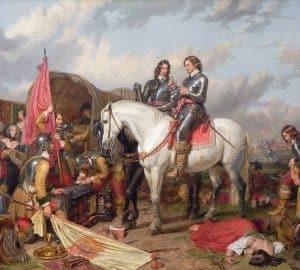
Gustav Adolph, who we know by the Latinzied form of his name Gustavus Adolphus, was born to King Charles of Sweden on December 9th, 1594. He grew up in this era of turmoil in his native Sweden and the continent of Europe. He was raised as a warrior prince and taught the art of war. It is said that when he was at the harbor when only five years old he said that his favorite ship was the one with the most guns. He was also well educated in more peaceful pursuits. He knew seven languages including Latin, German and Greek. In his letters he would switch between languages, pulling from whichever was most convenient.

Training
His father wanted Gustavus to be the next king, so he deliberately raised him for leadership. He brought his son to the council meetings, and by the time he was ten he was giving official answers to foreign ambassadors. On one occasion the king wrote to his son with this advice:
Before all things, fear God, honour thy father and mother, be tender to thy sisters, love those who have served me faithfully, reward them according to their deserts, be gracious to thy subjects, punish the evil, trust all men fairly, but only entirely when thou hast learnt to know them. Be no respecter of persons before the law; invade no man’s just privileges, provided they clash not with the law; diminish not thy regal possessions in favour of any man, except thou art sure that he will recognize the benefit and do thee good service in return.
Gustavus earnestly wanted to engage in war as soon as he could, and spent his spare time talking with officers experienced in combat. Finally in 1611, when he was only 17, he got his wish. He was knighted and sent off to fight in the war with Denmark. Gustavus spent his childhood preparing to take his role as a man, instead of wasting his time in frivolous pursuits. As one man wrote at the time, “He seems more occupied in ruling his kingdom than with the ordinary pleasures of youth.”

Appointed King

That year would see Gustavus’ life change even more drastically. On October 30 his father died, leaving the Swedish throne empty. His son, still nearly a boy, rose to take his place. The Swedish law said that a king must be at least 24, but the requirement was waived in Gustavus’ case, and he was crowned king on December 17, 1611. He was already well fitted for the position. An ambassador who saw him at the time wrote that he was “a man of high courage, though not revengeful; keen of intellect, watchful, active; an excellent speaker, and courteous in his intercourse with all men; from a youth of such promise great things are to be expected.” His chief minister was Axel Oxenstierna, his Chancellor. He was only 24, and served as the counter to Adolphus’ fiery disposition.
Victory in War
Few men, regardless of their age, have assumed the throne under more difficult circumstances. At the time, Sweden was engaged in two wars – one with Denmark, from which they had gained their independence a few decades before, and the other with Russia, where a Swede was trying to become Czar. The young king dove right in, beginning first with the Danes. The king led his people in battle, inspiring the common man with his presence. Throughout his life he was always risking his life in battle, and at this time he nearly died after falling through the ice during a battle on a frozen lake. Peace was eventually signed on January 19, 1613. The nobles of Denmark did not want King Christian to gain power through victory over Sweden, and Gustavus gained the right to purchase two important cities, which he soon did.
Gustavus also won victories in the war with Russia, and signed a peace treaty on February 27, 1617, gaining two provinces, including where St. Petersburg was later built. These two victories increased the power of Sweden in the Baltic. But Gustavus Adolphus could not rest on his laurels. Sigismund of Poland still wanted to regain the throne of Sweden, and Gustavus worked to build a coalition of allies for the war he knew was coming. One alliance was made by marrying Maria Eleonora, the daughter of the Elector of Brandenburg, a province of Germany. Although the marriage was for political reasons, Gustavus had traveled through Europe to find a bride while using the name Captain Gars (which stood for Gustavus Adolphus Rex Sueciae, Gustavus Adolphus King of Sweden).
In 1621 Sweden was again engaged in war, this time with Poland. Sigismund, cousin of Gustavus, was trying to regain the Swedish throne. Over the next year Gustavus captured several important cities, but then the war stalemated, and a truce was agreed on in 1622. At this time Sweden entered a short time of peace, and the Swedish king turned his attention to the war which was raging in Europe.
Sources
The Thirty Years War by C. V. Wedgwood
Gustavus Adolphus and the Struggle of Protestantism for Existence by C. R. L. Fletcher




